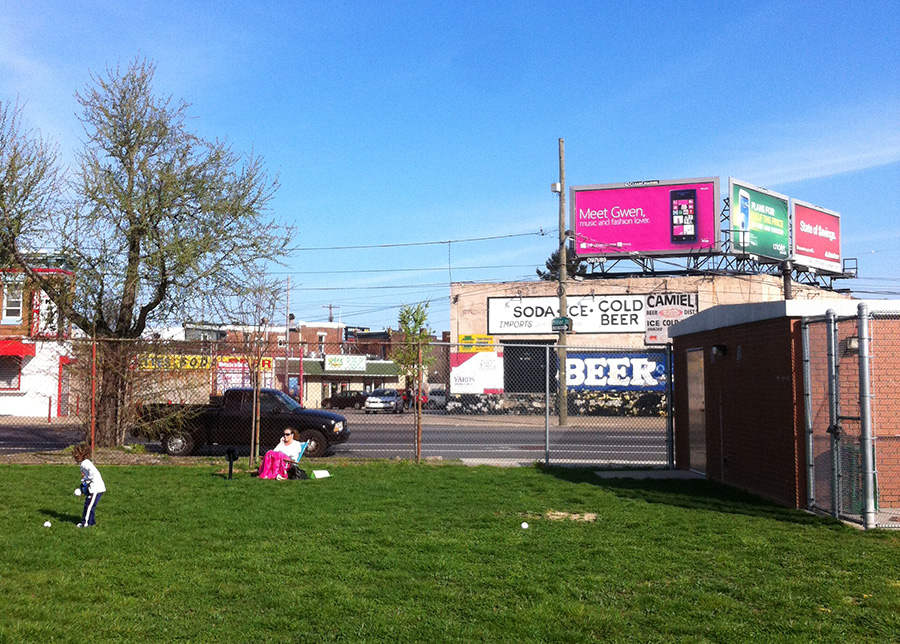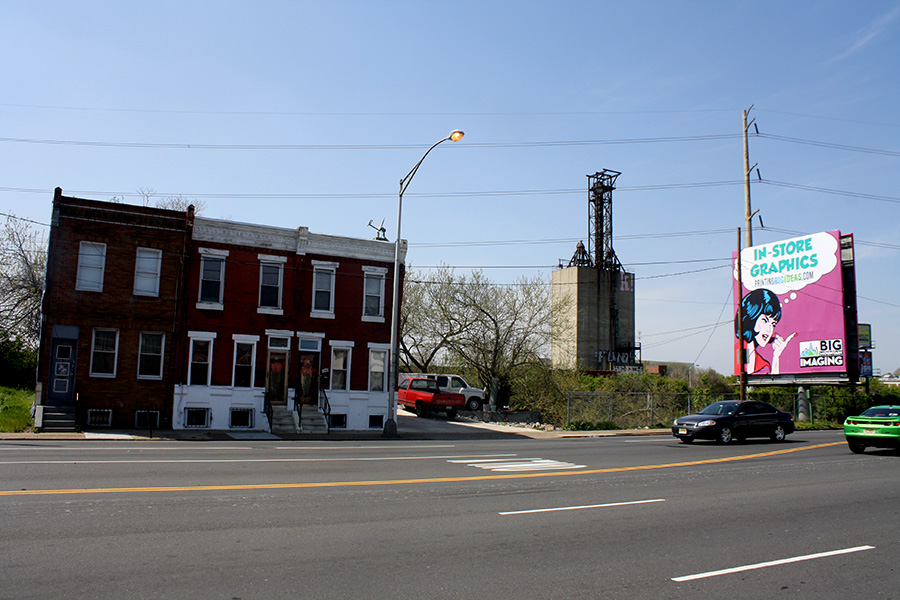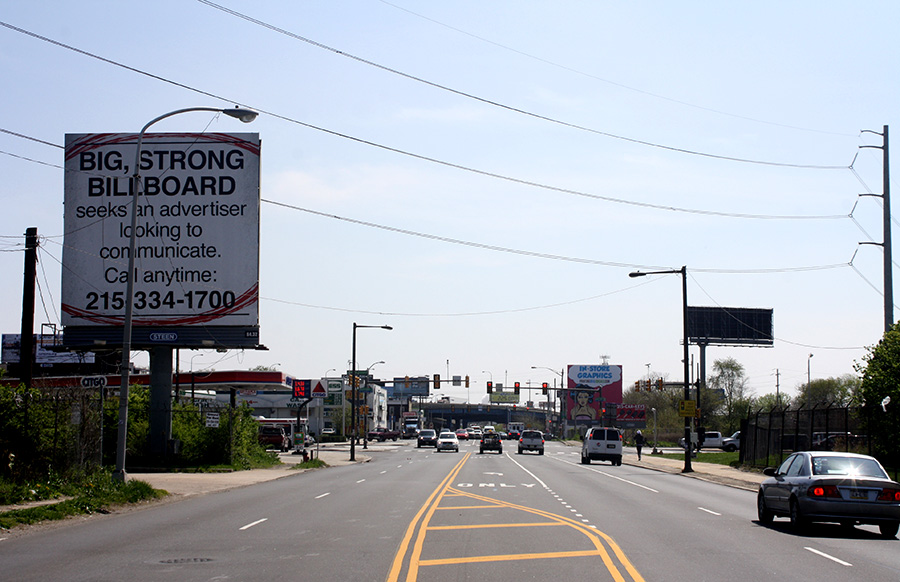Mixed messages: Philadelphia’s struggle to create lasting billboard regulations
The history of outdoor advertising regulation in Philadelphia is a saga of false starts. Two major overhauls of municipal billboard regulations, in 1991 and 2005, established clear new rules for how close billboards could be built to each other and to other uses, such as residential neighborhoods, parks, schools, and bridges. Both revisions also established higher annual license fees, and both were met immediately with lawsuits from the outdoor advertising industry, which succeeded in softening their impact.
A third recent overhaul—conducted over a period of two years by members of the Zoning Code Commission through public meetings, negotiations with private companies and advocacy groups, and several draft bills—appears stillborn. Sixth-District Councilman Bobby Henon, whose office took responsibility last year for getting the bill through Council, has shelved the legislation for now, saying the proposed regulations don’t reflect the reality of the local billboard environment.
“When I got involved, I was asking for a lot of information that I did not have, and it wasn’t until recently that I got the full information, or part information—I’m going to say not full, but part information—that I didn’t feel comfortable moving forward with the redraft of non-accessory signs,” Henon said. “I thought it was prudent and responsible for me to request to the chair of the Rules Committee that it be severed out of the zoning legislation last year to look at it separately, and then after a further look, decided to start over. I wasn’t comfortable—there was not a consensus for all the parties, and we dealt with all the stakeholders, from the City Law Department to City Planning, my office, other Council offices, the Rules Committee, and Scenic Philadelphia as well as the sign industry itself.”
No matter what the eventual new regulations end up saying, how vigorously they’ll be enforced is an open question. The Department of Licenses and Inspections, charged with monitoring zoning code compliance, is also charged with enforcing the building code, the plumbing code, the fire code, and so on. Spread thin, L&I can perhaps be forgiven for not making non-accessory signage a proactive priority.
But the billboard industry in Philadelphia has also employed a strategy of full-scale litigation to protect its assets from zoning regulations that it may feel threaten its bottom line.
A series of lawsuits aimed at the 2005 zoning law resulted in a settlement agreement, under which the Law Department agrees to treat most of the billboards in Philadelphia as legal. In exchange, the companies took on the one-time task of removing hundreds of 8-sheet billboards that had been posted illegally, many on the walls of bodegas and corner convenience stores. The settlement agreement also lowered the annual licensing fee for each sign face from $650, the rate the 2005 law had set, to $50.
Representatives of Clear Channel, CBS Outdoor, Steen, and Keystone—the four biggest outdoor advertising companies, whose holdings account for the vast majority of billboards in the city—either declined to speak to PlanPhilly about this topic or did not respond to requests for comment, as did several of the attorneys who represent them.
According to reports filed with the city, though, CBS Outdoor spent more than $53,000 in the second and fourth quarters of 2012 lobbying the Mayor’s Office for “statutory language which supports reasonable outdoor advertising.” David Posy, a CBS Outdoor vice president who filed the lobbying report, did not return phone calls from PlanPhilly, nor did the two local attorneys who signed the reports.
According to several sources who worked closely on the sign chapter that Henon’s office decided to hold, the sign companies did not like the final product.
“They were always very clear that they weren’t happy with the bill,” said Natalie Shieh, a former staff member of the Zoning Code Commission who now works for Deputy Mayor Alan Greenberger.
Everywhere a sign
Councilman Henon would not share the data he says he received from the major sign companies, and there appears to be no other complete, geographically accurate list of billboard locations available. Certified Inventories of sign locations given to the city as part of a 2006 settlement agreement with Clear Channel, CBS Outdoor, and Steen are thorough but somewhat imprecise.
Those companies, along with Keystone, operate a minimum of 1,917 non-accessory sign faces within the city limits, according to the 2006 inventories and information posted on the companies’ websites. That’s an average of 13 billboards per square mile, if evenly spread out.
PlanPhilly was able to clearly identify 183 separate billboard structures in the immediate vicinity of Interstate 95 on overhead photographs of the city. A geographic analysis of those sign structures performed by PlanPhilly and AxisPhilly shows that most do not conform to some of the most basic spacing requirements contained in the current zoning regulations:
-
39 stand in zoning districts where they’re not allowed to stand
-
Nearly a third (56) are placed within 300 feet of a residential zoning district
-
Nearly a third (54) are placed within 660 feet of a park
-
More than two thirds (134) are placed within 500 feet of another billboard
Many of those nonconforming structures—possibly all of them—are legal nonconformities, built prior to the adoption of the regulations they now violate, and therefore grandfathered in. The rule about nonconforming signs, like other nonconforming uses, is that they can be maintained, sometimes expanded slightly, but not moved or rebuilt.
The sign companies now want to convert as many billboards as possible to digital displays, which allow them to rotate advertisements throughout the day and make more money. The current zoning regulations prohibit converting nonconforming, static accessory signs to digital signs, but have nothing to say about digital conversions of non-accessory signs.
Under a legal interpretation of the code issued by City Solicitor Andy Ross, converting a nonconforming billboard to digital is considered a face change, for which the owner needs only to pull a permit. The sign controls prepared by the Zoning Code Commission working group would not have allowed any non-conforming sign to convert to digital.
“I know that the billboard industry was not happy [with the bill],” said Stacey Graham, an attorney who currently works for Councilman Curtis Jones, Jr., but who was instrumental in writing the new zoning code and working on the sign controls chapter as an aide to Councilman Bill Green. “There were some things that they wanted that we just felt were unreasonable. For example, the settlement agreement: they wanted all of those settlement agreement signs to have an automatic right to go digital. We felt that was unreasonable. We just felt that was unreasonable. I can’t say it any other way.”
Natalie Shieh said that the ZCC and Planning Commission’s point of view is that when a sign converts from static to digital, it becomes a new sign. She said that the impact of digital signs is much different than that of static signs, and that the structures needed to support them is distinct as well.
“I don’t think we would change our policy on that point of view,” Shieh said. “We might rethink where it makes sense. We might rethink spacing. We might rethink the rules that govern digital signs. But that one critical piece—is it a new sign?—I think we will always say, yes, it’s a new sign.”
Under the current zoning rules, though, it’s not a new sign—just a new face, for which a billboard owner can legally obtain an over-the-counter permit.
Another shot
Throughout the zoning reform process, representatives of the major sign companies worked together to fight for rules they felt would work for them. So did thousands of others, of course—that was the point of rewriting the zoning code through a public process.
The difference, says Natalie Shieh, is that in Philadelphia, the number of people representing the interests of the outdoor advertising industry is small, and their interests are aligned.
“In this process, they formed a coalition, and they are working collaboratively together,” Shieh said. “It’s a very strong alliance.”
On the other side of the spectrum is Scenic Philadelphia, the group formerly known as SCRUB, which has fought since the early 1990s for stronger and better-enforced billboard regulations. Lobbying reports show that Scenic spent $3,500 in the fourth quarter of 2012 advocating for amendments to the sign control bill, among other issues.
Don Elliott, of Clarion Associates, a national consultancy that has helped Philadelphia and other cities write new zoning codes, said it’s not unusual for sign regulations to be especially difficult to deal with, “because the stakes are high, and because feelings run high on all sides of the issue.”
“Whenever there are strongly held emotions,” Elliott said, “there’s going to be a tug-of-war.”
So a decision was made at the very beginning of the zoning reform process to put off rewriting sign controls until after the bulk of the new code was written. When the working group got around to it, it conducted a series of public meetings in different neighborhoods and with different interest groups. The rules it came up with were not meant to impact the settlement agreement between the sign companies and the Law Department, but they did contain a handful of new rules governing the size and location of outdoor ads.
The draft chapter contained, for the first time, rules governing how bright digital billboards could be, how frequently and how quickly their messages should change, and how far they needed to be from other uses. It also contained a fairly complex system of credits, wherein sign companies could earn points toward building new billboards by taking down others in targeted locations.
Natalie Shieh also said that the ZCC working group had asked the sign companies, on several occasions, to share its locational data, but that the companies did not respond to the requests. So the working group did what it could without that information.
“When the ZCC wrote the sign chapter, we held a number of public meetings …” said Stacey Graham. “And I felt that we got it very close to the mark in terms of what people in this city have a tolerance for in terms of outdoor signage. I felt that that was the model to work with and that it needed only minor tweaks, if any, to bring together a consensus to move forward on that legislation.”
Don Elliott said that the sign chapter went through several phases of redrafting after his group made its recommendations, but that there isn’t a single, off-the-shelf best practice that cities can use to regulate digital billboards.
“There is no standard one,” Elliott said. “We have drafted those kinds of things for several cities. There’s never a standard. Even though it seems obvious there should be a national standard in that area, there isn’t.”
Nonetheless, the zoning reform process, while imperfect, was probably the best chance the city will get for quite some time to express its collective, negotiated will for the future development and proliferation of billboards.
“It doesn’t surprise me,” said Don Elliott, when PlanPhilly informed him that the ZCC’s sign chapter has been set aside. “There’s a lot of politics behind it.”
Laws and lawsuits
In Philadelphia, the threat of litigation from the billboard industry, which also has a history of donating to local political campaigns, has measurable impacts not only on the policies that control outdoor advertising but also on the built environment itself.
It was fear of opposition from Keystone, which owns a high-mast billboard at 2nd and Race streets, that caused the developer of the proposed 205 Race apartment complex to change the design of the building to keep billboard views open, and that prompted the zoning legislation from 1st-District Councilman Mark Squilla that will allow the project to be built by right.
In 2010, before the ZCC got deep into sign controls, the billboard industry tried to save it the trouble by literally writing its own law. Steen drafted a bill and sent it to then-Councilman Frank DiCicco, who introduced the bill into City Council. It never moved forward, but the fact of its introduction is a testament to how close the sign companies can be to the ears of local politicians.
The lawsuits filed after the 2005 bill took effect—a First Amendment-based suit entered by three companies organized as “Free Speech, LLC”—led to a settlement agreement which vastly lowers the annual fees companies have to pay for their signs. Under the original bill, the city would have pulled in around $1.25 million this year in license fees for the minimum 1,917 sign faces owned by the four biggest companies. Instead, under the consent agreement terms, those companies owed just $95,850. Andy Ross explained that the legal question, unresolved in this case because of the settlement, is whether a fee can be used as a source of revenue.
(PlanPhilly has sought records of how much money in fees the Department of L&I has actually collected over the last several years, but had not received it by the time this article was published.)
The companies had also sued to block a 7 percent outdoor advertising excise tax—paid by the advertiser, not the billboard owner—but under the terms of the settlement agreed to suspend its challenge of the tax. The tax has brought in roughly $2.5 million a year.
“I think that a review of case law in Philadelphia and elsewhere shows that this industry is litigious,” said Stacey Graham, who also says she supports outdoor advertising, and hopes that Council President Clarke’s municipal advertising program gets implemented. “Municipalities are aware of this and that knowledge plays an important role when elected officials and municipal legal departments begin to draft sign regulations. In my opinion, the role it plays is one of intimidation.”
Even when courts have ruled against sign companies over individual billboards, the companies have sometimes managed to keep them standing.
In one case, Interstate Outdoor Advertising—a company run by Drew Katz, whose father, Lewis Katz, is a part owner of the city’s two daily newspapers—put up billboards on a strip of recreationally zoned land across I-95 from FDR Park. The Court of Common Pleas ruled that the owners hadn’t shown the hardship necessary to receive the variance they’d gotten from the ZBA—billboards are not allowed in recreational zoning districts. The Commonwealth Court agreed with the lower court on appeal, and both the State and U.S. Supreme Courts declined to hear further appeals. Even still, Interstate was able to strike a deal with the city to keep the signs up.
Andy Ross was unable to locate that agreement by the time this article was published, so its terms are not known.
In another instance, Keystone lost a court battle with Scenic Philadelphia (then SCRUB) over a billboard at 25 Pattison Avenue. The company made an agreement with the Philadelphia Authority for Industrial Development, which owns the land, to place a sign on the site. When Keystone went to pull permits, L&I denied them, because the sign would be within 500 feet of two other signs, and within 600 feet of the Walt Whitman Bridge, both of which are prohibited areas.
The zoning board then granted Keystone a variance, which SCRUB appealed to the Court of Common Pleas. Common Pleas overturned the ZBA decision, and the Commonwealth Court sided with Common Pleas, writing, “a desire for more economic profit is not an economic hardship satisfying the requirements for a zoning variance.” That billboard is still standing, though Andy Ross said he doesn’t believe it’s the subject of a specific agreement. Keystone signed onto the settlement agreement between the City and Free Speech, LLC (Steen, CBS, and Clear Channel) in 2007.
Ross says the sign industry’s litigiousness isn’t particularly special or surprising.
“I can’t really answer for whether they are more influential more than somebody else,” Ross said. “They do whatever they do to advance their interests, like most people in business.”
Enacting new sign controls—especially ones that include a clear policy about digital sign conversions—is the unfinished business of zoning reform in Philadelphia. Councilman Henon says he intends to reconvene a working group over the summer to write a new bill.
“I think the consent agreement is a status quo for the industry,” Henon said. “It’s not a progressive, policy-setting agreement, but it’s the status quo for the time.
Note: An earlier version of this article said the sign companies “refused” to share data with the Zoning Code Commission. Natalie Shieh points out that it’s more accurate to say that they did not respond to data requests.
WHYY is your source for fact-based, in-depth journalism and information. As a nonprofit organization, we rely on financial support from readers like you. Please give today.






